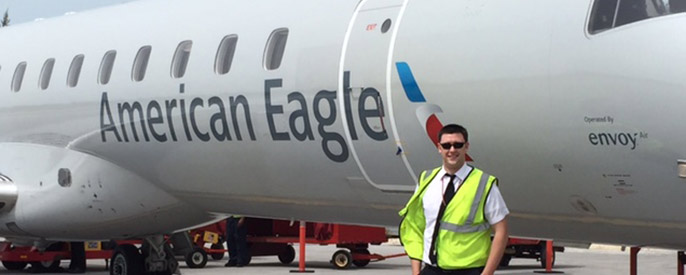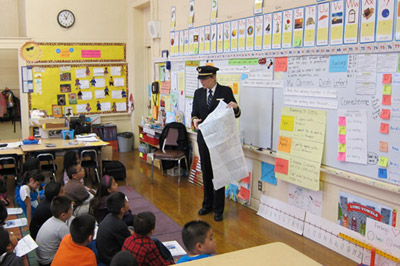A Day in the Life of a Reserve Pilot
F/O Thomas (T.J.) Fogarty
As a reserve pilot, I’m tasked with covering any flights that are not assigned to another pilot that month, or a trip that the originally scheduled pilot can no longer make for any of a number of reasons—e.g., yearly training, sudden sickness, or weather delays/cancellations on earlier flights. Reserve pilots like myself help an airline get the operation back on schedule after severe weather or other large service disruptions.
Generally, a reserve schedule goes to a newer pilot; however, some pilots choose to bid reserve to get weekends or holidays off or time at home. I often have various personal events that I would like to attend scattered throughout the month, and sometimes, having a regular schedule makes it impossible for me to attend some events. Reserve schedules are a little less consistent (I may have five days on and three off, so the days of the week I have off vary), and because of this, there is frequently a reserve schedule available that makes it possible for me to attend more events.
As a reserve at my current airline, I can look to see what trips are open for the following day. If a trip looks like something that would work for me, I submit a preference, and if I’m the most senior pilot to request that trip, I’ll get it. If there aren’t many trips to choose from, I’ll end up on a reserve availability period (RAP) or airport standby.
A RAP is a period of 14 hours when I’m on call for that day. I could begin as early as 4 a.m. and get done as late as midnight. During the 14-hour window, I have two hours to get to the airport if I am called and another 45 minutes from my sign-in time to depart on the flight. This type of assignment can last anywhere from a short flight out and back to my domicile (home base) up to a six-day trip.
Alternately, airport standby is a type of reserve in which I would wait at the airport to be called on short notice for a flight that needs to be covered. Sometimes, a pilot becomes sick on short notice, a crew is delayed coming into a base, or a flight has been added to our list for the day from another type of airplane. Airport standby pilots answer a call and often leave on a flight to a new destination within as little as 30 minutes.
When I am assigned a trip, I fly as a first officer on the Embraer 145 based at Chicago O’Hare International Airport (ORD). It’s an exciting and busy environment, and each day has its own unique challenges.
Today I’m going to ORD for an 8:30 a.m. departure to Harrisburg, Penn., and back. I start getting ready about three hours before departure to make it from my home to the terminal in time to prepare for my flight. In Chicago, I give myself some extra time for traffic, and I like getting to work early so I’m not rushed.
I get to the terminal in plenty of time today, but the airplane is running a little late. There were many cancellations due to weather yesterday, so we are still working to get airplanes and pilots back on schedule. I meet my crew for the day; we introduce ourselves and chat about the upcoming flight. Once the passengers exit and we get a short briefing on the airplane and weather from the crew that just flew in, we sit down and begin our preparations for flight.
As a first officer, I am tasked with reviewing the maintenance log, aircraft documents and safety equipment, assuring the exterior of the airplane is in safe condition, and reviewing the paperwork for the flight. We look at the weather for our route, and it looks good most of the way with just a few rain showers as we get closer to our destination. The captain and I finish our duties about the same time the last passengers are boarding and the remaining bags are being loaded into the cargo hold.
We miss our official departure time out of ORD due to the late arrival of the airplane, but are able to turn the aircraft (deplane and board passengers and cargo) in about 25 minutes. We run our pre-departure checklists to make sure everything is set properly, get pushed back from the gate, start the engines, and taxi to the runway after a few more checklists and calls for clearance on the radio.
ORD is busy this morning, so it takes a few minutes for us to get in line to takeoff. We configure the airplane for takeoff and verify with more checklists to make sure everything is in order, then we get our clearance to take off. We line up on the runway, add full power, and at about 150 mph I pull back on the yoke, and we become airborne. After several heading and altitude changes to get us clear of the congested ORD airspace, and—you guessed it—a few more checklists, we’re well on our way.
After a while, things start to settle down, and we get comfortable for our two-hour flight to Harrisburg. I chat with the captain about new events around the company and industry, and we also catch up on personal things. Having been at the company for several years, I have flown with and already know many of our captains, and I like to get to know the new ones.
As expected, the weather is a little bumpy and rainy on the descent into Harrisburg, but things clear up once we get lower. I circle around the far side of the airport to land into the wind on Runway 31. I always enjoy flying into this airport because it’s built right next to a river in a shallow valley. It’s early spring, and today the river is up nearly to the level of the runway as the snow melts off for the year. Good thing for the levy built between us and the river!
We’re just a few minutes behind schedule as we pull into the gate, and the ground crew at the airport works hard to get us back in the air quickly so that we can make up a few minutes to get passengers to ORD on schedule. Many passengers have connecting flights to other destinations past Chicago, and while we never jeopardize safety to save time, we do what we can to help passengers make their connecting flights. As I am still on reserve with no further assignment after this roundtrip, I also just found out that I have been assigned to fly a Cincinnati turn (out and back) when I get back to ORD. All part of being a reserve pilot! One flight down, and three more to go for today.
While some pilots dislike not knowing their schedule in advance, I find that it makes things a little more exciting to be sent to destinations on short notice or to pick up a fun flight or overnight layover during the week. It also helps me to make a schedule that works better for me. The reserve system is different at every airline, so this is not always possible. But at my company, reserve affords me the opportunity to fly trips that I would not otherwise be able to get with my seniority. It also makes it possible to have weekends and holidays off and be able to spend important times with family.
For now I plan to enjoy my last month as a first officer—next month I’m off to training to become a captain!
We hope you enjoyed this insight into what a typical day in the life of a reserve pilot can be. If you have any questions, please contact ALPA’s Education Committee at Education@alpa.org.



